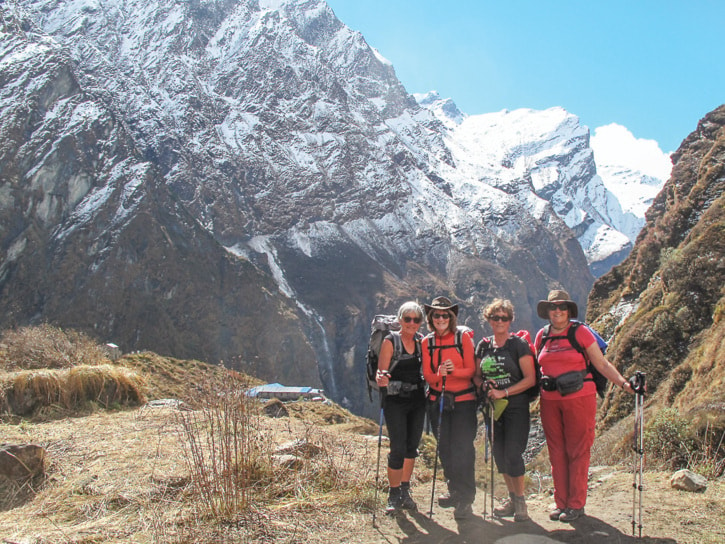Four Salmon Arm women celebrated highs and lows on a 12-day trek in the mountains of Nepal.
Eileen MacDonald, Ruth Brighouse, Maureen McTavish and Joyce Johnson were hiking the Anapurna Sanctuary trail in mid-October when avalanches triggered by a cyclone killed 45 people and injured some 170 on the Anapurna Circuit located on the other side of the mountain.
Brighouse and MacDonald sat down to tell of their adventures on behalf of the four close friends. The women, who love the outdoors and met through a variety of activities, have been hiking, skiing and canoeing together for 20 years.
In 2011, Brighouse, a doctor, went on a one-month volunteer medical mission on the edge of Kathmandu.
“I didn’t have time to do any hiking, but I could see the mountains above and thought I’d love to be able to come back and hike,” she says, noting she told McTavish about her interest. “In the beginning of 2014, she said ‘I think I can free up some time to go to Nepal, so let’s go this fall.’”
Unsure of how to go about the trek, the women contacted Moon Mountain Adventures through a friend and the company customized a trip for them. Used to backpacking, they were amazed that their entourage included a bus driver, his helper, a chef, a chef’s helper and 10 porters – including one 18-year-old girl and four 17-year-old boys.
“The newly bred and nearly dead,” laughs Brighouse, pointing out the sanctuary trek is considered an easy trip for new porters and those who have retired from the high mountain treks. Rules of the sanctuary require permits and a guide and most trekkers stay in tea houses along the trail.
“We wanted to do it the traditional way – camp and take a longer route,” says MacDonald, who notes the porters took exceptional care of the women.
At 6 a.m. someone would appear at their tent with hot, spicy tea to warm them up. Half-an-hour later, a basin of hot water for bathing would arrive.
“We would dress and pack and they’d take down our tents and take off to the next stop while we sat down to a hot breakfast of porridge, eggs, meat, cheese, chapati and roti with jam and peanut butter,” says Brighouse with a grin. “And we would stop for an early lunch that lasted two hours.”
“There was always a tablecloth and tray with matching cloth; always salad, soup a main course and always a treat,” adds MacDonald, noting the crew did laundry at lunch because that’s when the wind is best for drying.
It took eight days to hike up to 14,000 feet, with concerned porters continually counselling, ‘Bistari Mum, bistari,’ Nepali for ‘Slowly Mum, slowly.’
“You don’t measure in kilometres, rather by the amount of time it takes to climb up the ridges where the villages are located and back down to the rivers below,” says MacDonald. “You go by elevation and because of elevation sickness, some days we went farther than others.”
That risk was further reduced because they went shorter distances each day than most organized tours.
“We tried not to exceed 500 metres in a day, but we might go up above that many times; maybe up 1,200 metres, but we’d come right back down,” says Brighouse, noting the trail is handcrafted of large stones by locals, who pack them in on their backs. “It’s up, up, up, down, down, down and sometimes, at the end of the day, we’d look over and see the town we started in across a large ravine.”
The women said a cyclone brought intense rain on their fifth day on the trail. It flooded McTavish and Johnson’s tent but brought no avalanches.
“The day of the cyclone, the (trail) steps were a waterfall. We hiked for the morning and then stopped,” said MacDonald.
They did not hear about the deadly avalanches on the other side of the mountain until day seven and were shocked to hear that four Canadian women had died. Knowing family and friends would be worried, they accessed Internet and sent messages home as soon as they could.
While they thrilled to the awesome beauty of Nepal, Brighouse and MacDonald favour the beauty of B.C.’s wider vistas.
“We were up at 14,000 feet and still the mountains were towering above us another 10,000 to 15,000 feet. I called them sky giants,” says Brighouse, noting the steep ridges and deep valleys create tight vistas.
The women plan to carry on trekking and are looking forward to another trip into the more familiar wilds of B.C.
“We have two cowboys that pack us out to the mountains into the wilderness every summer,” says MacDonald.
